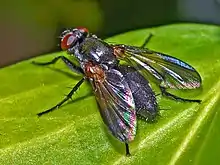| Paykullia maculata | |
|---|---|
 | |
| Scientific classification | |
| Domain: | Eukaryota |
| Kingdom: | Animalia |
| Phylum: | Arthropoda |
| Class: | Insecta |
| Order: | Diptera |
| Family: | Calliphoridae |
| Subfamily: | Rhinophorinae |
| Tribe: | Phytonini |
| Genus: | Paykullia |
| Species: | P. maculata |
| Binomial name | |
| Paykullia maculata | |
| Synonyms | |
| |
Paykullia maculata is a species of fly in the subfamily Rhinophorinae[5][6] first described by Carl Fredrik Fallén in 1815.[7]
Distribution
This species can be found in most of Europe (Austria, Great Britain, Czech Republic, Denmark, France, Germany, Hungary, Ireland, Italy, Spain, Norway, Poland, Slovakia, Sweden, Switzerland, Netherlands) [8][9] Habitats include wetlands, woodlands, parks and gardens.[10]
Description
Paykullia maculata can reach a length of 5–6 millimetres (0.20–0.24 in). The adults of this species are very variable, especially in size and in the pattern of wing markings.[9] These small flies have a shining black body with bristly hair. The apical half of the wings show darkened veins and costal area.[10][11][12]
Biology
Adults can be seen from May to September, with several generations. Usually they rest or run around on stones or among the foliage.[9] The larvae are intestinal parasites of Porcellio scaber and Oniscus asellus,[10] and woodlice from Protracheoniscus and Trachelipus genera.[9]
References
- 1 2 Fallén, C.F. (1815). "Beskrifning öfver några Rot-fluge Arter, hörande till slägterna Thereva och Ocyptera". Kongliga Vetenskaps Academiens Nya Handlingar. 1815 (3): 229–240.
- ↑ Macquart, P.J.M. (1855). "Nouvelles observations sur les insectes diptères d'Europe de la tribu des tachinaires (Fin)". Annales de la Société Entomologique de France. 3 (3): 177–204, 4 pls. Retrieved 12 July 2023.
- ↑ Macquart, P.J.M. (1845). "Nouvelles observations sur les insectes diptères de la tribu des tachinaires". Annales de la Société Entomologique de France. 3 (2): 237–280. Retrieved 14 June 2023.
- 1 2 Robineau-Desvoidy, André Jean Baptiste (1830). "Essai sur les myodaires". Mémoires presentés à L'Institut des Sciences, Lettres et Arts, par divers savants et lus dans ses assemblées: Sciences, Mathématiques et Physique. 2 (2): 1–813. Retrieved 15 July 2018.
- ↑ Cerretti, Pierfilippo; Badano, Davide; Gisondi, Silvia; Lo Giudice, Giuseppe; Pape, Thomas (15 Jan 2020). "The world woodlouse flies (Diptera, Rhinophoridae)". ZooKeys (903): 1–130. doi:10.3897/zookeys.903.37775. PMC 6976704. PMID 31997887. Retrieved 2 December 2023.
- ↑ Yan, Liping; Pape, Thomas; Meusemann, Karen; Kutty, Sujatha Narayanan; Meier, Rudolf; Bayless, Keith M; Zhang, Dong (2021). "Monophyletic blowflies revealed by phylogenomics". BMC Biology. 19 (230). Retrieved 2 December 2023.
- ↑ Jedlička, Ladislav; Kúdela, Matúš; Stloukalová, Viera (2009-01-01). "Rhinophoridae Robineau-Desvoidy, 1863". Checklist of Diptera of the Czech Republic and Slovakia. Electronic version 2. Bratislava, Slovakia: Comenius University. ISBN 978-80-969629-4-5.
- ↑ "Paykullia maculata (Fallen, 1815) | Fauna Europaea". fauna-eu.org. Retrieved 2018-07-30.
- 1 2 3 4 Joachim Ziegler, ed. (2008). "4.3.20 Rhinophoridae". Diptera Stelviana. A dipterological perspective on a changing alpine landscape. Results from a survey of the biodiversity of Diptera (Insecta) in the Stilfserjoch National Park (Italy). Halle: Ampyx-Verlag. pp. 221–228. ISBN 9783932795305. OCLC 554886269.
- 1 2 3 "Paykullia maculata | NatureSpot". www.naturespot.org.uk. Retrieved 2018-07-30.
- ↑ Bei-Bienko, G.Y. & Steyskal, G.C. (1988) Keys to the Insects of the European Part of the USSR, Volume V: Diptera and Siphonaptera, Parts I, II. Amerind Publishing Co., New Delhi.ISBN 81-205-0080-6 ISBN 81-205-0081-4
- ↑ F. I. van Emden (1954). Diptera - Cyclorrhapha. Calyptrata (I) Section (a). Tachinidae and Calliphoridae (PDF). Handbooks for the Identification of British Insects. Vol. 10 Part 4a ii. London: Royal Entomological Society.